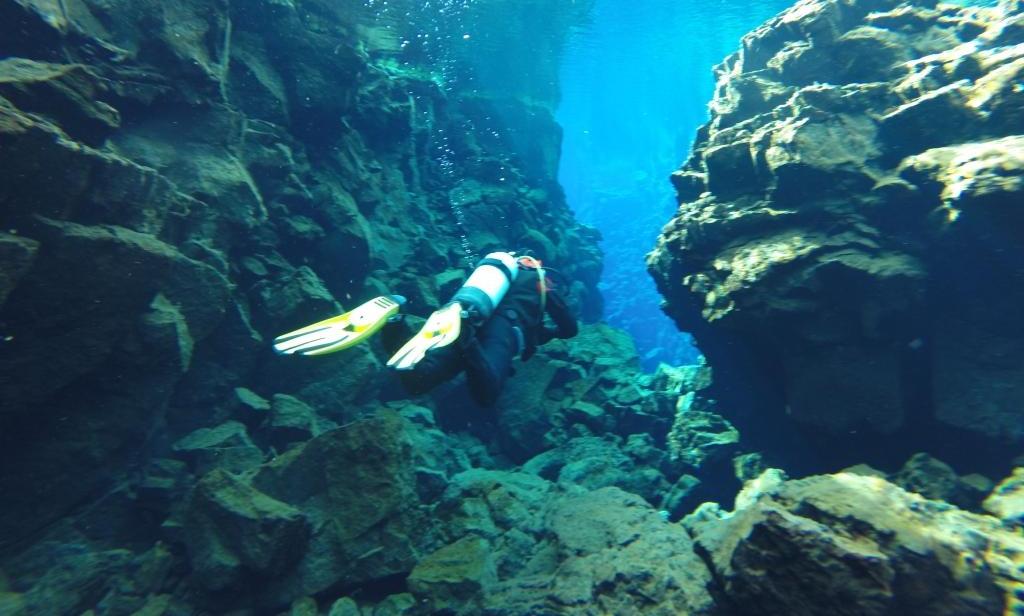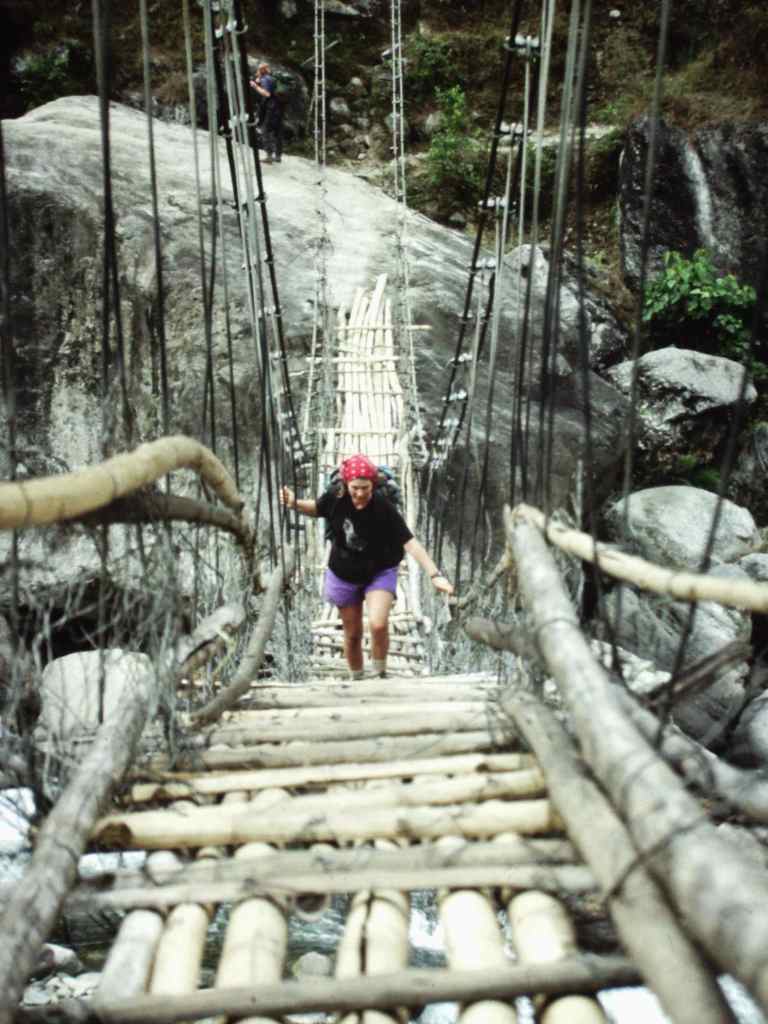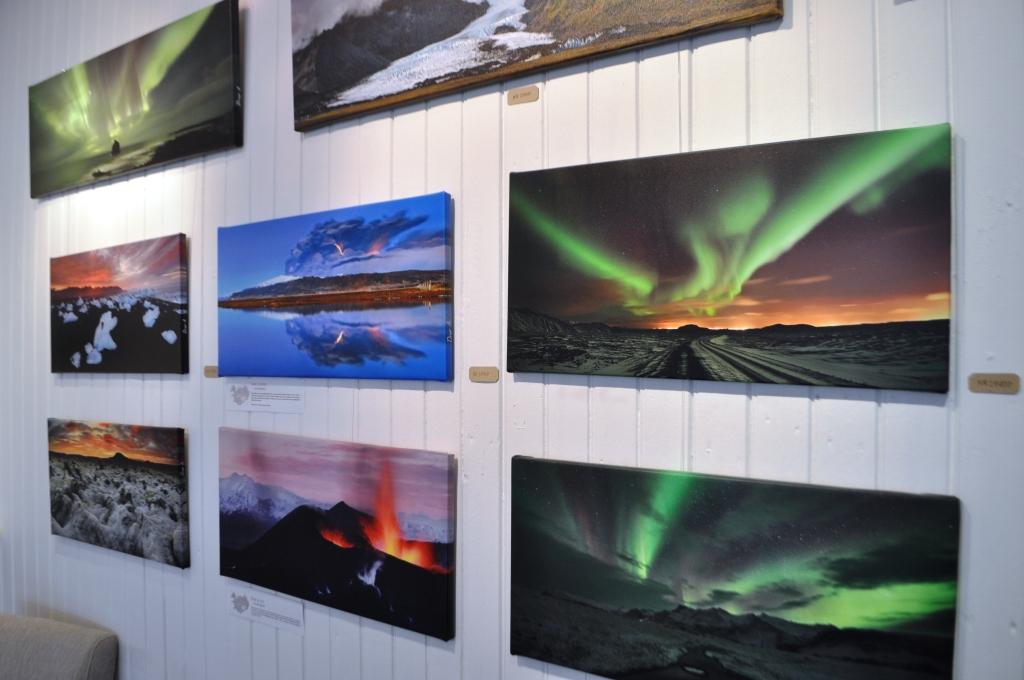Tentative: In the illustrated dictionary of my imaginings, the word has a picture of me sitting between the Eurasian and North American continental plates, getting up the nerve to immerse myself in water that is 35 degrees Fahrenheit.
I’m so ready for the shock of numbing cold that when I dip the tip of my rubber flipper into the water, I spring back, even though my actual foot is nowhere near the actual water. Of course, the fins have no nerves so I feel nothing except some slight embarrassment. I slide the flipper in farther until the water reaches my foot. To my surprise, all I feel is a gentle coolness.
I am wearing two pairs of socks, two layers of long underwear, and a adult-sized onesie made out of the sort of quilted insulation you find in sleeping bags. The effect is part Michelin man, part astronaut. Over all that goes the rubber dry suit, followed by extra bands that act as seals around the neck and hands. The dry suit includes booties, which fit over my socks. All that — feet, socks, and booties — get jammed into the flippers. There’s also a neoprene hood and some “crab claw” gloves, which have individual fingers for my thumb and index finger, and a partial mitten for the other three fingers.
And if that isn’t enough to haul around, there is still the normal complement of SCUBA gear: BC, tank, regulator, and about 23 pounds of lead, more than usual because the clothing is buoyant. I waddle from the staging area in the parking at Iceland’s Thingvellir National Park to the jumping-in point where, geologically speaking, North America and Europe come within a few yards of each other.
In Your Bucket Because….
- This is a one-of-a-kind experience. Nowhere else in the world can you dive (or snorkel) in fresh ice- water between continental plates.
- The dive is stunningly beautiful, and a fantastic way to try out dry-suit diving.
- Good for adventure-prone divers and snorkelers.
And now it’s show time The water I am about to jump into started as snowfall thousands of years ago, was pressed into glacial ice, slid down a mountain, melted into volcanic soil, spent between 30 and 100 years being filtered through rock, then emerged here in a spring. It is so pure you can drink it without a second thought, so clear that you can see for 100 meters, not to mention all the way down to the jumble of rocks at the bottom.
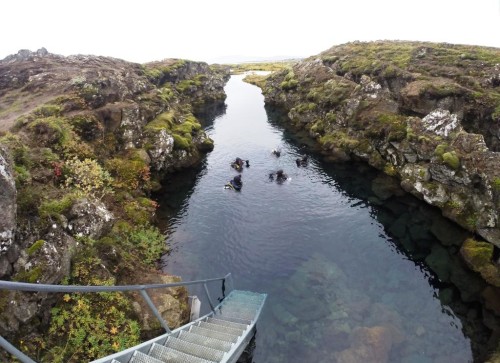
We’ll be diving in the cleft between the plates, in a channel through the middle. “Don’t go into any caves,” our guide warns us. “And try not to grab onto the rocks. There are miniature earthquakes here every day, and sometimes the rocks fall down.” Indeed, the continental plates here are moving apart at the rate of about two centimeters a year, which is huge in geological time.
So, to summarize, I am diving in an active earthquake zone in water that was until perhaps days or weeks ago, glacial ice.
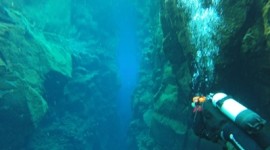
I slide in a little farther, surprised to feel my legs enveloped in nothing worse than a slight coolness. The real test will be when I get as far as neck and hands. A leak can turn a dry suit into a wet suit, and short of punctures, the most likely place to spring a leak is at the seals. With a mighty surge of will, I abandon my inch-at-a-time entry strategy, and plunge all the way in. The seals follow the curves of my skin, and even when I’m fully immersed, I feel little more than a twinge of chilliness, although there’s a bit of brain freeze as my head hits the water. I soon get used to it, and get down to business, checking buoyancy and working with the unfamiliar valve on the dry suit. I’m an experienced diver, but this is my first time in a dry suit. Everything works as it is supposed to.
On a signal, we descend and start our underwater tour through the geological maze. Every once in a while, I have to adjust my buoyancy, as our dive path requires us to rise and dip to move through the rocks. But mostly, I gape at the cliffs surrounding me on each side. In terms of underwater life, there isn’t much that wants to live in 35 degree fresh glacial water, except for some occasional algae. But the rocks are dramatic. In terms of a view, it’s like rock-climbing, except wet. The water has the clarity and color of fine jewels: turquoise up close, aquamarine farther out, and sapphire in the distance.
Thingvellir National Park
Located less than an hour’s drive from Reykjavik, Thingvellir (Þingvellir in Icelandic) means “Parliament Plains.” The nation’s first parliament — the Alþing general assembly — was established here in 930, and continued to meet in the same place until 1798. Place names like Gallows Rock, the Drowning Pool, and Law Rock tell some of the history of this revered national park.
Thingvellir is also part of one of Iceland’s most popular tourist routes, the so-called Golden Circle, a tour that takes in Gullfoss, Iceland’s most photographed waterfall, and Geysir, whose hot springs gave us the word geyser. It’s a one-day outing from the capital, and some companies (see “Practicalities”) include snorkeling or diving as part of the itinerary.
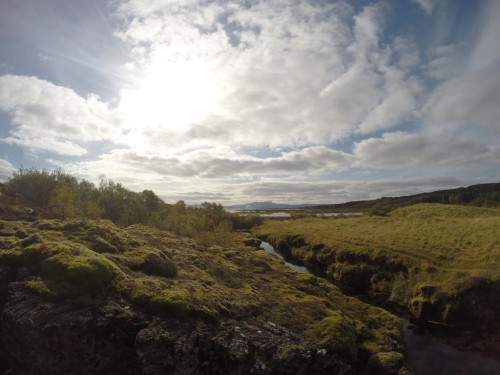
On a dedicated dive trip, the typical itinerary includes two dives. During the surface interval between them you hike about 200 meters back to the staging area with all your gear (although if you struggle, the guides will cheerfully help with tanks and weights). You trade out tanks and warm up with hot soup and drinks before hauling everything back to the dive site and doing it all over again. Iceland’s weather is unsettled, so the surface interval between the dives can be more or less pleasant. Our lucky group had a mostly sunny, windless day.
When we returned to the water for the second dive, everything felt different. I didn’t think twice before plunging in, and I handled the valves on my dry suit like I knew what I was doing. The dive was slow and relaxed. The gear that had seemed unfamiliar and cumbersome on land was now a part of my body. The sun danced in the clear water like light through a diamond, and the air from my breathing rose in clear bubble that expanded into brilliant balloons as they rose to the surface.
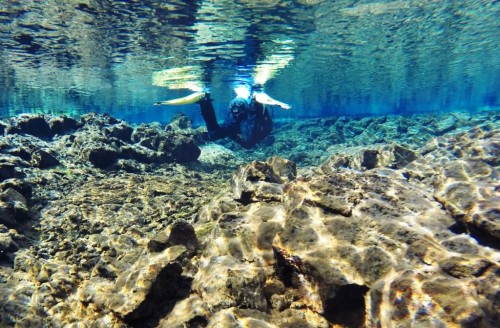
Exhilarated: In the illustrated dictionary of my imaginings, the word is accompanied by a picture of me emerging from the waters of Thingvellir after a dive that lived up to the hype.
Practicalities
- Snorkeling and diving are both offered. Divers do not need to be dry suit certified. You’ll get a brief orientation to how to use the equipment and manage buoyancy. In terms of confidence and knowing what to expect, it helps to read up on dry-suit diving before you go.
- Be brutally honest when you report your height and weight when you sign up for the trip: Your dry suit and insulating suit will be chosen for you according to the information you provide. Mine fit perfectly, meaning there was no room to shave off a few pounds.
- You can drive to the parking lot staging site at the park in your rental car, but picks ups from Reykjavik hotels are available and included in the price.
- It’s usually a two-tank dive with a surface interval in between. Our group was divided into two subgroups of about four to six divers each. Our did a 35-minute dive and a 25-minute dive. The dives are shallow drift dives (Maximum 18 meters; average depth about 10 meters) with a somewhat odd profile, determined by the slope of the bottom. Dive times are limited by the cold and how long it takes to get from one end to the other.
- This is a freshwater dive with no sea life; the most you’ll see is some colored algae. But the rock formations and water clarity are what put this list on “best of” lists the world over.
- Dives go all year, including winter, but if the air temperature is below freezing, you’ll only do one dive as equipment can freeze during the surface interval.
- For more information, Dive.is or Extreme Iceland. Dry suit certification is also available. I dove with Dive.is and was very satisfied with the level of instruction and with gear that did not leak.
